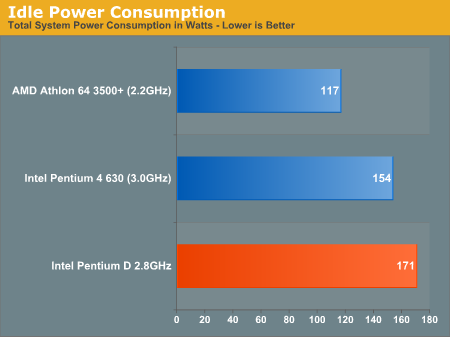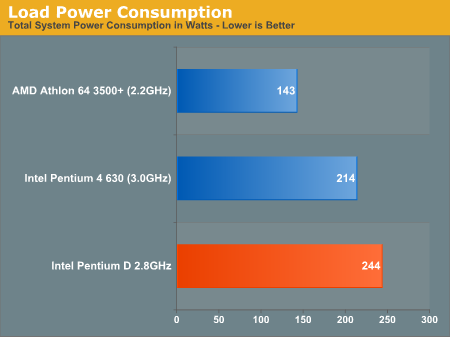Intel Dual Core Performance Preview Part II: A Deeper Look
by Anand Lal Shimpi on April 6, 2005 12:23 PM EST- Posted in
- CPUs
I'll admit, dual core has me excited for many of the reasons outlined in Part I. A big part is that personally, I've been using multiprocessor systems in my main computer for years. I've always appreciated the benefits of multiprocessor platforms, but recommending one for a desktop user has never been really feasible. Even the cheapest 2P workstation motherboards were at least twice the price of a desktop motherboard, not to mention the cost of the CPUs. The mass market had a short affair with multiprocessing in the days of the ABIT BP6 and the Celeron 300A, but in the grand scheme of things, that was barely a blip on the radar. Now, for the first time, both AMD and Intel are ready to bring the type of robustness of multiprocessor platforms to the desktop with their dual core offerings.
Part I focused on what dual core can offer, but now it's time for a much more practical look. We've never recommended Intel's Extreme Edition line of processors nor AMD's FX series, both supposedly marketed to gamers, but not purchased by any of our gaming readers. The processors that we recommend are usually much better values for the price, and thus, today's comparison isn't based around the most expensive dual core offerings, but rather the cheapest.
A point we made in the first article was that Intel's pricing strategy for dual core is extremely aggressive, with the cheapest 2.8GHz Pentium D soon to be introduced at $241. The problem is that at only 2.8GHz, the Pentium D won't have the strongest single threaded performance, which puts buyers in a sticky situation - do you buy an Athlon 64 3500+ for great single threaded performance or will the Pentium D give you a better overall multitasking experience? Intel doesn't do much to complicate the situation, as the Pentium D 2.8GHz will be close in price to the Pentium 4 630 (3.0GHz), which isn't much of a clock speed advantage. AMD will eventually have competitively priced dual core parts, but right now, AMD doesn't appear to be looking at the mainstream desktop market for dual core Athlon 64 chips.
The three chips mentioned above are the basis of the majority of today's comparison, but the decision is far from clear cut. Let's find out why.
Power Consumption
We'll start with power consumption - the contenders? A 90nm Athlon 64 3500+ vs. the Pentium 4 630 and the dual core 2.8GHz Pentium D. As always, we measured total system power at two states: idle and under a full load. For our full load test, we used a multithreaded application, 3ds max 7, performing the CBALLS2 render test from the SPECapc benchmark.


The K8 architecture simply lends itself to lower power consumptions than Intel's high frequency approach to computing with the Pentium 4 (especially Prescott). The move down to 90nm really reduced AMD's power consumption a lot, to the point where the 90nm Athlon 64 3500+ actually consumes less power under full load than the Pentium 4 630 at idle.
The Pentium 4 vs. Pentium D comparison is also interesting, as the 2nd core doesn't add all that much to overall system power consumption. In this case, we're looking at an increase in overall system power consumption by less than 15%. Intel still doesn't win in the power consumption department though; if you want something cool and quiet, AMD is still the way to go.
The Test
Our hardware configurations are similar to what we've used in previous comparisons.
AMD Athlon 64 Configuration
Socket-939 Athlon 64 CPUs
2 x 512MB OCZ PC3200 EL Dual Channel DIMMs 2-2-2-10
NVIDIA nForce4 Reference Motherboard
ATI Radeon X850 XT PCI Express
Intel Pentium 4 Configuration
LGA-775 Intel Pentium 4 and Extreme Edition CPUs
2 x 512MB Crucial DDR-II 533 Dual Channel DIMMs 3-2-2-12
Intel 955X Motherboard
ATI Radeon X850 XT PCI Express










106 Comments
View All Comments
segagenesis - Wednesday, April 6, 2005 - link
#45 - The Athlon 64 still lags behind on encoding cabability and its been shown over the past year. However some of the content tested was designed specifically for P4 optimization so its hard to get a reliable result. Who knows... until we see the new AMD64 core with SSE3 we cant really pass judgement.Quanticles - Wednesday, April 6, 2005 - link
AMD needs to send Anandtech one of their dual-cores with a DFI nForce4 SLI board.That'd shut a lot of people up.
If AMD owns single thread, then why wouldnt they own dual core. People would be throwing money away buying intel's dual core.
Spearhawk - Wednesday, April 6, 2005 - link
The first graph on the DVD Shrink/Game bench still seems a bit suspect. Why would the P4 outperform the PD and the A64 when under normal circumstances the A64 should be superior in singlethread and the PD in multithread?Anway, great article. I'm really looking forward to seeing what AMD has to offer since while I'd greatly like improved multitasking I'd also like a good gaming CPU.
Marlin1975 - Wednesday, April 6, 2005 - link
What about overclocking the Dual core chip???Regs - Wednesday, April 6, 2005 - link
Ah, I mis read it. You used the Intel 955X.I have to ask then, is it because of AMD's onboard memory controller that they don't have to manufacture another motherboard for the dual core CPUs? If so, you think AMD was thinking about this scenero (dual cores) well before the first clawhammer came out?
That would sound impressive. Compared to Intel's dual press hots.
segagenesis - Wednesday, April 6, 2005 - link
#37 - Well im hard pressed to really want one when my current setup is still sufficient. That and I have my heart set on AMD64 for gaming. Even at DVD backup I can do a movie in about an hour even with full quality under DVD Shrink. And really, I would use DVD Rebuilder which is very much single threaded and in my book Quality > Speed. Takes about 6-7 hours but better results than DVD Shrink could have wished for.Anand Lal Shimpi - Wednesday, April 6, 2005 - link
RegsThe nForce4 Intel Edition platform was unrelated to the Intel dual core platform, it was just something I was working on at the time.
The platform arrived DOA, I'm guessing it's an error on NV's part.
Take care,
Anand
Jeff7181 - Wednesday, April 6, 2005 - link
"AMD's dual core will be quite impressive, even more so than Intel's. Don't look at performance as the only vector to measure though... "You like to tease us, don't you? :)
Regs - Wednesday, April 6, 2005 - link
Hey Anand, I noted that you said in Part one that the Intel Dual core was one of the most stable config's you ever had. However in part two and quote, "After recovering from Part I and realizing that my nForce4 Intel Edition platform had died, I was hard at work on Part II of the dual core story. "Was this human error or was it a manufacturing error?
michael2k - Wednesday, April 6, 2005 - link
#26: Actually, encoding a DVD should be a multi-tasking event in of itself!Task1: DVD creation; menu's, transitions, etc
Task2: DVD encoding; background rendering of menu's and transitions
Task3: DVD encoding; background rendering of the actual menu
Task4: Burning of DVD; you should be able to start burning the DVD before the encoding in task 2 or 3 is complete, as long as the burner is properly buffered